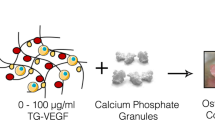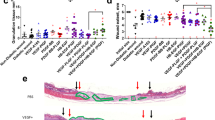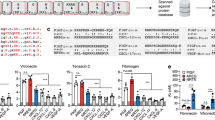Abstract
Growth factors can stimulate tissue regeneration, but the side effects and low effectiveness associated with suboptimal delivery systems have impeded their use in translational regenerative medicine. Physiologically, growth factor interactions with the extracellular matrix control their bioavailability and spatiotemporal cellular signalling. Growth factor signalling is also controlled at the cell surface level via binding to heparan sulfate proteoglycans, such as syndecans. Here we show that vascular endothelial growth factor-A (VEGF-A) and platelet-derived growth factor-BB (PDGF-BB) that were engineered to have a syndecan-binding sequence trigger sustained low-intensity signalling (tonic signalling) and reduce the desensitization of growth factor receptors. We also show in mouse models that tonic signalling leads to superior morphogenetic activity, with syndecan-binding growth factors inducing greater bone regeneration and wound repair than wild-type growth factors, as well as reduced tumour growth (associated with PDGF-BB delivery) and vascular permeability (triggered by VEGF-A). Tonic signalling via syndecan binding may also enhance the regenerative capacity of other growth factors.
This is a preview of subscription content, access via your institution
Access options
Access Nature and 54 other Nature Portfolio journals
Get Nature+, our best-value online-access subscription
$29.99 / 30 days
cancel any time
Subscribe to this journal
Receive 12 digital issues and online access to articles
$99.00 per year
only $8.25 per issue
Buy this article
- Purchase on Springer Link
- Instant access to full article PDF
Prices may be subject to local taxes which are calculated during checkout







Similar content being viewed by others
Data availability
All the data supporting the results in this study are available in the Article and Supplementary Information. The datasets generated and analysed during the study are available from the corresponding author on reasonable request.
References
Briquez, P. S., Clegg, L. E., Martino, M. M., Gabhann, F. M. & Hubbell, J. A. Design principles for therapeutic angiogenic materials. Nat. Rev. Mater. 1, 15006 (2016).
Briquez, P. S., Hubbell, J. A. & Martino, M. M. Extracellular matrix-inspired growth factor delivery systems for skin wound healing. Adv. Wound Care 4, 479–489 (2015).
Martino, M. M., Briquez, P. S., Maruyama, K. & Hubbell, J. A. Extracellular matrix-inspired growth factor delivery systems for bone regeneration. Adv. Drug Deliv. Rev. 94, 41–52 (2015).
Martino, M. M. et al. Growth factors engineered for super-affinity to the extracellular matrix enhance tissue healing. Science 343, 885–888 (2014).
Martino, M. M. et al. Engineering the growth factor microenvironment with fibronectin domains to promote wound and bone tissue healing. Sci. Transl. Med. 3, 100ra189 (2011).
Herbert, S. P. & Stainier, D. Y. Molecular control of endothelial cell behaviour during blood vessel morphogenesis. Nat. Rev. Mol. Cell Biol. 12, 551–564 (2011).
Baldo, B. A. Side effects of cytokines approved for therapy. Drug Safety 37, 921–943 (2014).
Marti-Carvajal, A. J. et al. Growth factors for treating diabetic foot ulcers. Cochrane Database Syst. Rev. 10, CD008548 (2015).
Galiano, R. D. et al. Topical vascular endothelial growth factor accelerates diabetic wound healing through increased angiogenesis and by mobilizing and recruiting bone marrow-derived cells. Am. J. Pathol. 164, 1935–1947 (2004).
Ferguson, M. W. et al. Prophylactic administration of avotermin for improvement of skin scarring: three double-blind, placebo-controlled, phase I/II studies. Lancet 373, 1264–1274 (2009).
Barrientos, S., Brem, H., Stojadinovic, O. & Tomic-Canic, M. Clinical application of growth factors and cytokines in wound healing. Wound Repair Regen. 22, 569–578 (2014).
Niu, Y., Li, Q., Ding, Y., Dong, L. & Wang, C.. Engineered delivery strategies for enhanced control of growth factor activities in wound healing. Adv. Drug Deliv. Rev. https://doi.org/10.1016/j.addr.2018.06.002 (2018).
Martino, M. M. et al. Extracellular matrix and growth factor engineering for controlled angiogenesis in regenerative medicine. Front. Bioeng. Biotechnol. 3, 45 (2015).
Rogers, K. W. & Schier, A. F. Morphogen gradients: from generation to interpretation. Annu. Rev. Cell Dev. Biol. 27, 377–407 (2011).
Kwon, M. J., Jang, B., Yi, J. Y., Han, I. O. & Oh, E. S. Syndecans play dual roles as cell adhesion receptors and docking receptors. FEBS Lett. 586, 2207–2211 (2012).
Afratis, N. A. et al. Syndecans – key regulators of cell signaling and biological functions. FEBS J. 284, 27–41 (2017).
Reiland, J. & Rapraeger, A. C. Heparan sulfate proteoglycan and FGF receptor target basic FGF to different intracellular destinations. J. Cell Sci. 105, 1085–1093 (1993).
Chen, E., Hermanson, S. & Ekker, S. C. Syndecan-2 is essential for angiogenic sprouting during zebrafish development. Blood 103, 1710–1719 (2004).
Lee, Y. H. et al. Processing of syndecan-2 by matrix metalloproteinase-14 and effect of its cleavage on VEGF-induced tube formation of HUVECs. Biochem. J. 474, 3719–3732 (2017).
Baeyens, N. et al. Syndecan 4 is required for endothelial alignment in flow and atheroprotective signaling. Proc. Natl Acad. Sci. USA 111, 17308–17313 (2014).
Purushothaman, A. et al. Heparanase-enhanced shedding of syndecan-1 by myeloma cells promotes endothelial invasion and angiogenesis. Blood 115, 2449–2457 (2010).
Fukai, N. et al. Syndecan-1: an inhibitor of arterial smooth muscle cell growth and intimal hyperplasia. Arterioscler. Thromb. Vasc. Biol. 29, 1356–1362 (2009).
Das, S., Majid, M. & Baker, A. B. Syndecan-4 enhances PDGF-BB activity in diabetic wound healing. Acta Biomater. 42, 56–65 (2016).
Choi, Y., Chung, H., Jung, H., Couchman, J. R. & Oh, E. S. Syndecans as cell surface receptors: unique structure equates with functional diversity. Matrix Biol. 30, 93–99 (2011).
Domogatskaya, A., Rodin, S. & Tryggvason, K. Functional diversity of laminins. Annu. Rev. Cell Dev. Biol. 28, 523–553 (2012).
Miner, J. H. Laminins and their roles in mammals. Microsc. Res. Tech. 71, 349–356 (2008).
Suzuki, N. et al. Syndecan binding sites in the laminin α1 chain G domain. Biochemistry 42, 12625–12633 (2003).
Mochizuki, M. et al. Angiogenic activity of syndecan-binding laminin peptide AG73 (RKRLQVQLSIRT). Arch. Biochem. Biophys. 459, 249–255 (2007).
Hozumi, K., Suzuki, N., Nielsen, P. K., Nomizu, M. & Yamada, Y. Laminin α1 chain LG4 module promotes cell attachment through syndecans and cell spreading through integrin α2β1. J. Biol. Chem. 281, 32929–32940 (2006).
Hoffman, M. P. et al. Laminin-1 and laminin-2 G-domain synthetic peptides bind syndecan-1 and are involved in acinar formation of a human submandibular gland cell line. J. Biol. Chem. 273, 28633–28641 (1998).
Negishi, Y. et al. Preparation and characterization of laminin-derived peptide AG73-coated liposomes as a selective gene delivery tool. Biol. Pharm. Bull. 33, 1766–1769 (2010).
Shim, A. H. et al. Structures of a platelet-derived growth factor/propeptide complex and a platelet-derived growth factor/receptor complex. Proc. Natl Acad. Sci. USA 107, 11307–11312 (2010).
Martino, M. M., Briquez, P. S., Ranga, A., Lutolf, M. P. & Hubbell, J. A. Heparin-binding domain of fibrin(ogen) binds growth factors and promotes tissue repair when incorporated within a synthetic matrix. Proc. Natl Acad. Sci. USA 110, 4563–4568 (2013).
Martino, M. M. & Hubbell, J. A. The 12th–14th type III repeats of fibronectin function as a highly promiscuous growth factor-binding domain. FASEB J. 24, 4711–4721 (2010).
Sarabipour, S. & Mac Gabhann, F. VEGF-A121a binding to Neuropilins – a concept revisited. Cell Adh. Migr. 12, 204–214 (2018).
Goh, L. K. & Sorkin, A. Endocytosis of receptor tyrosine kinases. Cold Spring Harb. Perspect. Biol. 5, a017459 (2013).
Schense, J. C. & Hubbell, J. A. Cross-linking exogenous bifunctional peptides into fibrin gels with factor XIIIa. Bioconjug. Chem. 10, 75–81 (1999).
Lutolf, M. P. et al. Synthetic matrix metalloproteinase-sensitive hydrogels for the conduction of tissue regeneration: engineering cell-invasion characteristics. Proc. Natl Acad. Sci. USA 100, 5413–5418 (2003).
Chen, W. et al. PDGFB-based stem cell gene therapy increases bone strength in the mouse. Proc. Natl Acad. Sci. USA 112, E3893–E3900 (2015).
Bonvin, C., Overney, J., Shieh, A. C., Dixon, J. B. & Swartz, M. A. A multichamber fluidic device for 3D cultures under interstitial flow with live imaging: development, characterization, and applications. Biotechnol. Bioeng. 105, 982–991 (2010).
Caplan, A. I. & Correa, D. PDGF in bone formation and regeneration: new insights into a novel mechanism involving MSCs. J. Orthop. Res. 29, 1795–1803 (2011).
Friedlaender, G. E., Lin, S., Solchaga, L. A., Snel, L. B. & Lynch, S. E. The role of recombinant human platelet-derived growth factor-BB (rhPDGF-BB) in orthopaedic bone repair and regeneration. Curr. Pharm. Des. 19, 3384–3390 (2013).
Kaipel, M. et al. BMP-2 but not VEGF or PDGF in fibrin matrix supports bone healing in a delayed-union rat model. J. Orthop. Res. 30, 1563–1569 (2012).
Luvizuto, E. R. et al. Effect of recombinant PDGF-BB on bone formation in the presence of β-tricalcium phosphate and bovine bone mineral matrix: a pilot study in rat calvarial defects. BMC Oral Health 16, 52 (2016).
Spicer, P. P. et al. Evaluation of bone regeneration using the rat critical size calvarial defect. Nat. Protoc. 7, 1918–1929 (2012).
Gurtner, G. C., Werner, S., Barrandon, Y. & Longaker, M. T. Wound repair and regeneration. Nature 453, 314–321 (2008).
Radu, M. & Chernoff, J. An in vivo assay to test blood vessel permeability. J. Vis. Exp. 16, e50062 (2013).
Kilarski, W. W. et al. Intravital immunofluorescence for visualizing the microcirculatory and immune microenvironments in the mouse ear dermis. PLoS ONE 8, e57135 (2013).
Tortelli, F., Pisano, M., Briquez, P. S., Martino, M. M. & Hubbell, J. A. Fibronectin binding modulates CXCL11 activity and facilitates wound healing. PLoS ONE 8, e79610 (2013).
Ishihara, J. et al. Laminin heparin-binding peptides bind to several growth factors and enhance diabetic wound healing. Nat. Commun. 9, 2163 (2018).
Martino, M. M. et al. Inhibition of IL-1R1/MyD88 signalling promotes mesenchymal stem cell-driven tissue regeneration. Nat. Commun. 7, 11051 (2016).
Ng, C. P., Hinz, B. & Swartz, M. A. Interstitial fluid flow induces myofibroblast differentiation and collagen alignment in vitro. J. Cell Sci. 118, 4731–4739 (2005).
Kubota, K., Sakikawa, C., Katsumata, M., Nakamura, T. & Wakabayashi, K. Platelet-derived growth factor BB secreted from osteoclasts acts as an osteoblastogenesis inhibitory factor. J. Bone Miner. Res. 17, 257–265 (2002).
Marden, L. J., Fan, R. S., Pierce, G. F., Reddi, A. H. & Hollinger, J. O. Platelet-derived growth factor inhibits bone regeneration induced by osteogenin, a bone morphogenetic protein, in rat craniotomy defects. J. Clin. Investig. 92, 2897–2905 (1993).
Ranly, D. M. et al. Platelet-derived growth factor inhibits demineralized bone matrix-induced intramuscular cartilage and bone formation. A study of immunocompromised mice. J. Bone Joint Surg. 87, 2052–2064 (2005).
Hanft, J. R. et al. Phase I trial on the safety of topical rhVEGF on chronic neuropathic diabetic foot ulcers. J. Wound Care 17, 30–32, 34–37 (2008).
Traub, S. et al. The promotion of endothelial cell attachment and spreading using FNIII10 fused to VEGF-A165. Biomaterials 34, 5958–5968 (2013).
Martino, M. M. et al. Controlling integrin specificity and stem cell differentiation in 2D and 3D environments through regulation of fibronectin domain stability. Biomaterials 30, 1089–1097 (2009).
Hildebrand, T., Laib, A., Muller, R., Dequeker, J. & Ruegsegger, P. Direct three-dimensional morphometric analysis of human cancellous bone: microstructural data from spine, femur, iliac crest, and calcaneus. J. Bone Miner. Res. 14, 1167–1174 (1999).
Lutolf, M. P. et al. Repair of bone defects using synthetic mimetics of collagenous extracellular matrices. Nat. Biotechnol. 21, 513–518 (2003).
Julier, Z., Martino, M. M., de Titta, A., Jeanbart, L. & Hubbell, J. A. The TLR4 agonist fibronectin extra domain A is cryptic, exposed by elastase-2; use in a fibrin matrix cancer vaccine. Sci. Rep. 5, 8569 (2015).
Xu, D., Fuster, M. M., Lawrence, R. & Esko, J. D. Heparan sulfate regulates VEGF165- and VEGF121-mediated vascular hyperpermeability. J. Biol. Chem. 286, 737–745 (2011).
Acknowledgements
The authors thank the Bioimaging and the histology platform of Ecole Polytechnique Fédérale de Lausanne and Monash University. This work was partially funded by the European Community’s Seventh Framework Programme in the project Angioscaff (grant no. NMP-LA-2008-214402) to J.A.H. and M.A.S., by the Swiss National Science Foundation (grant no. P2ELP3_1750 71) to Z.J., by the National Institutes of Health, National Institute of Diabetes and Digestive and Kidney Diseases (grant no. DP3DK108215) to J.A.H. and by the National Health and Medical Research Council (grant no. APP1140229) to M.M.M. The Australian Regenerative Medicine Institute is supported by grants from the State Government of Victoria and the Australian Government.
Author information
Authors and Affiliations
Contributions
M.M., J.A.H. and M.M.M. designed the research. M.M., E.G., A.J.P., Z.J., P.S.B. and M.M.M. conducted the experiments and analysed the data. G.A.K. and R.M. conducted the microCT measurements and analyses. M.A.S. supervised the flow chamber and microvascular permeability experiments. M.M., E.G. and M.M.M. wrote the manuscript. J.A.H. and M.M.M. supervised the research.
Corresponding author
Ethics declarations
Competing interests
Monash University and Ecole Polytechnique Fédérale de Lausanne have filed for patent protection on the molecular design described herein; M.M., J.A.H. and M.M.M. are named as inventors.
Additional information
Publisher’s note Springer Nature remains neutral with regard to jurisdictional claims in published maps and institutional affiliations.
Supplementary Information
Supplementary Information
Supplementary figures and video captions.
Supplementary Video 1
Syndecan-binding VEGF-A induces low vascular permeability (example 1).
Supplementary Video 2
Syndecan-binding VEGF-A induces low vascular permeability (example 2).
Rights and permissions
About this article
Cite this article
Mochizuki, M., Güç, E., Park, A.J. et al. Growth factors with enhanced syndecan binding generate tonic signalling and promote tissue healing. Nat Biomed Eng 4, 463–475 (2020). https://doi.org/10.1038/s41551-019-0469-1
Received:
Accepted:
Published:
Issue Date:
DOI: https://doi.org/10.1038/s41551-019-0469-1
This article is cited by
-
A superior extracellular matrix binding motif to enhance the regenerative activity and safety of therapeutic proteins
npj Regenerative Medicine (2023)
-
Systemically administered wound-homing peptide accelerates wound healing by modulating syndecan-4 function
Nature Communications (2023)
-
SDC4-rs1981429 and ATM-rs228590 may provide early biomarkers of breast cancer risk
Journal of Cancer Research and Clinical Oncology (2023)
-
Controlled release of growth factors using synthetic glycosaminoglycans in a modular macroporous scaffold for tissue regeneration
Communications Biology (2022)
-
An instantly fixable and self-adaptive scaffold for skull regeneration by autologous stem cell recruitment and angiogenesis
Nature Communications (2022)



